Is Detroit is Worth Visiting?
categories: USA Travel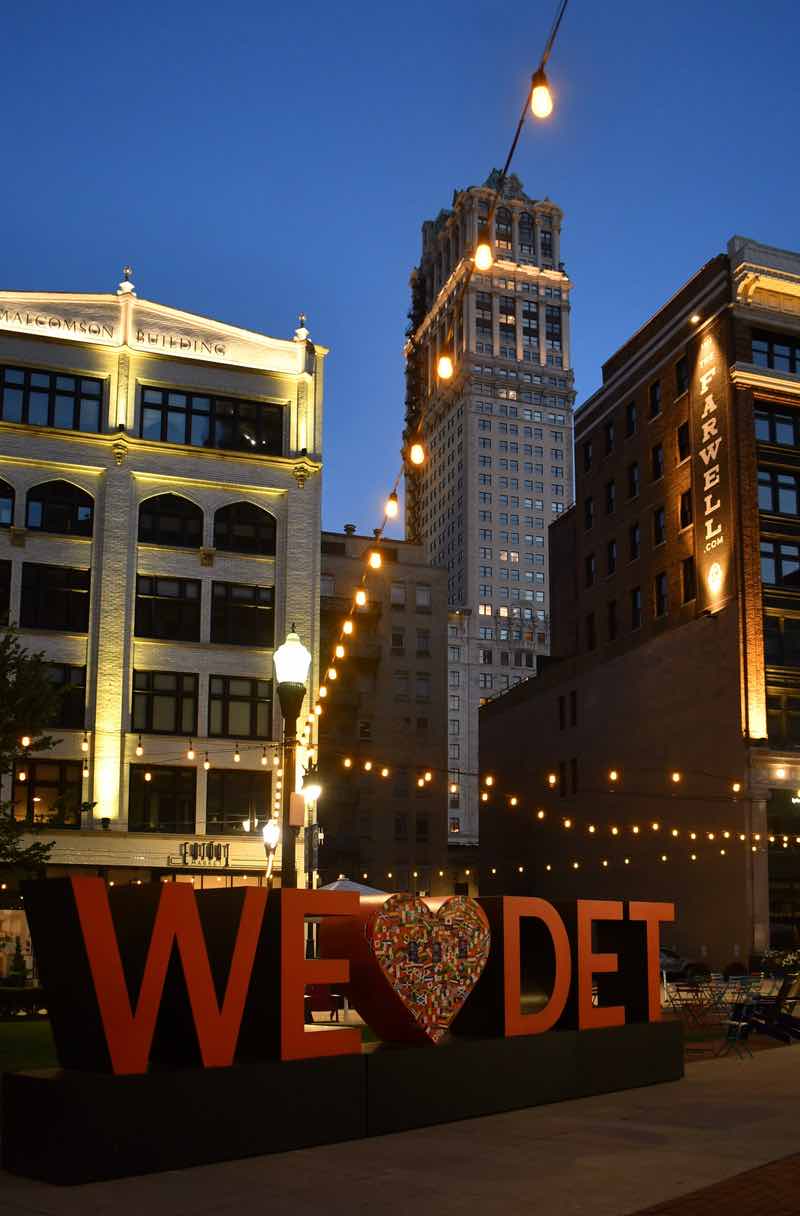
Capitol Park at Night
Voted by TIME Magazine as one of the World’s Greatest Places, there is a growing global recognition that Detroit, with its rebirth, is a great getaway for travelers looking for something new. Detroit has the reputation of being sometimes unapproachable and the saying, “Lock the doors and roll up the windows,” was a long-standing comment.
But the city is making a comeback and it is now gaining positive reviews for its attractions and safety. The Motor City features luxurious hotels and charming attractions that rival other major US cities. Here are the top reasons to visit Detroit.

The Renaissance Center
The Architecture
The architect who was one of the most critical in shaping the skyline of Detroit was Albert Kahn, who designed multiple skyscrapers, office buildings, and mansions dotting the metro area. Some notable structures include the Ford River Rouge Auto Plant, the Fisher Building, the Detroit Free Press Building, the Packard Automotive Plant, the Edsel and Eleanor Ford House, the National Theater, and the Bonstelle Theater.
One of his structures, the Detroit Free Press Building, at 321 W. Lafayette, was constructed in 1924 and held one of the largest Detroit newspapers for years. With its Art Deco style and limestone facade carved with bas-relief figures symbolizing commerce, the building is a testament to the beautiful architecture Kahn brought to the city. The Press/321 is now under renovation for apartments.
The Detroit Renaissance Center (construction began in 1971), with its three shimmering glass towers, is one of the most recognizable structures on the city’s skyline. Its hotel tower, now part of the Marriott, is still the tallest building in Michigan. In 1996, the “RenCen” was purchased by General Motors and became the company’s headquarters. The complex is so large, with 14 acres of offices, restaurants, and shops, that it has its own zip code.
Another extraordinary building to visit in Detroit is the Guardian Building built during the Roaring Twenties. Its architect, Wirt C. Rowland, got inspiration from the Native Americans and Aztecs to create a bold, colorful brick and terracotta structure whose splendid details are continued from its exterior to its interior. Shops are located inside, and while browsing what they have to offer, you can take in the arched ceilings highlighted with brilliant tiles and painted murals, crafted by over forty artists.
Interior of the oldest aquarium in the nation, Belle Isle Aquarium.
The Parks
Detroit is a city with alluring parks tucked here and there, just waiting for a stroll. One of the largest is the International Riverfront, a series of parks spanning 5.5 miles, snaking from the Ambassador Bridge down to Belle Isle. The Detroit Riverfront Conservancy, a 501c3 organization, realized early on the importance of preserving public access to the river and enhancing its beauty. The Riverwalk was voted number one in the country by USA Today in 2023 and is one of my favorite places to walk with my two shepherds. It is active 24 hours a day and well-lit. At the numerous parks, security is a visible presence.
One of the busiest places along this ribbon of land is the Cullen Plaza. With spacious parking and a building housing a food vendor along with restrooms, this park is a perfect place to see the beauty of the Detroit and Windsor skyline. The park also boosts a whimsical carousel with colorful water-dwelling creatures that are indigenous to the Detroit River, just beckoning you for a ride. The Cullen Family Carousel was created by Briggs Design and handcrafted specifically for the Detroit Riverfront.
An absolute gem of Detroit is Belle Isle, a 982-acre state-owned island park sitting in the Detroit River and accessible by the historic 2,193-foot MacArthur Bridge built in 1923 with its nineteen arches. On the island are multiple biking and hiking paths looping around wetlands, forests, and historical Detroit architecture. The James Scott Memorial Fountain constructed in 1925 with a diameter of 510 feet is guarded by stone lions and playful angels.
The remains of the zoo still can be viewed along the wooded river path along with a vintage casino whose facade harkens to a former time. Beaches and park areas are strewn throughout the island along with a municipal golf course. The oldest aquarium can be found here with its intricate exterior and bright lime tile on the inside. If you want to get lost in fauna from around the world, go to the Anne Scripps Whitcomb Conservatory from 1904, the oldest in the nation.
Resting on the island is the old Belle Isle Police Station with large grand doors for police horses, built to maintain order on the isle. In 1928, a dispatch was established, and radio calls were broadcast. In 2014, when the island was taken over as a state park, conservation officers and state troopers now keep the peace.
Another historic fixture is the Detroit Yacht Club, established in 1868, perched on the north side of the island. The building sits on its own man-made private island and was designed by George D. Mason, in the classic Mediterranean Revival style. Other features of the isle are a golf range, a historic casino, and the Dossin Great Lakes Museum, highlighting the history of the Great Lakes.
Located in the heart of Detroit, Campus Martius Park is a lively public square framed by iconic skyscrapers that hosts events throughout the year, from ice skating in the winter to movie nights during the summer. During the holidays, the park is festooned in Christmas lights that sparkle in the night and a large, decorated tree standing stately above its seasonal ice rink.

The southside of Detroit.
Hart Plaza borders the Renaissance Center with the Detroit River flowing on their southsides. Opened in 1975, the plaza contains the famous Horace E. Dodge and Son Memorial Fountain, whose silvery circle spouts water onto the hot pavement to cool river walkers. Hart Plaza hosts numerous festivals throughout the summer, including the Windsor-Detroit International Freedom Festival, with its spectacular, striking display of vibrant fireworks to celebrate the 4th of July. A large, open amphitheater provides the stage and seating for these celebrations and its backdrop is a wonderful view of downtown.

Inside the John K. King Book Store.
The Attractions
Signal Return is another hidden treasure in Detroit, nestled next to the Eastern Market. Signal is a community letterpress shop where wood and metal type line the walls watched over by platen and sign presses. A gift shop contains handmade, unique prints along with an opportunity to make your own creations in hands-on art workshops.
The John King Book Store was established in 1965 in Dearborn, Michigan, and moved to Detroit in 1971. In 1983, King purchased an abandoned glove factory to house the store which currently holds over a million books. To walk into the store is like taking a walk back in time and leaving the digital age behind while immersing yourself in row upon row of printed tomes illuminated by the splices of light cutting through the heavy glass factory windows.
Interesting merchandise, such as antique statues and faded comics, nestle among the books, and the stairwells are decorated with artwork from local artists and old prints. Glass cases bathed in soft light highlight antiques from eras past and the smell of forgotten memories permeates every level. The store harkens to crime movies of the past where the protagonist yanks a volume off the shelf and flips through its pages to solve a mystery. The John King Book Store is a delight for anyone who loves the feel and smell of old stories.
Z lot, located from the corner of East Grand River and Broadway to the corner of Gratiot and Library, is a ten-story parking garage filled with murals from artists around the world. It is a popular site for selfies and portraits featuring the Detroit skyline, or vibrant, bold artwork in the background. Residing between the two wings of the Z lot is a cobblestone, art-strewn alley, also known as the Belt, which hosts establishments with food, spirits, and music.
If you want to take a walk in the wild, then head over to the DNR Outdoor Adventure Center. Located in the historic Globe building, you are greeted by an elk and sturgeons as you walk through the entrance. Enjoy a waterfall, climb a hanging bridge, step into a fishing boat, or see the native fish swimming in the aquarium. The Adventure Center is a place where you can explore the great outdoors while not stepping outside the city.
The Elmwood Cemetery is Detroit’s oldest non-denominational church, encompassing 86 acres. Many notable people of history are buried here, including George DeBaptiste, who worked with Frederick Douglas during the abolitionist movement; Margaret Mather, a great Shakespearean actress of the nineteenth century; Douglass Houghton, Michigan’s first state geologist; along with governors, mayors, and veterans of all wars. Running through the property is Bloody Run Creek, named for the Native American massacre of Captain Dalzell. Stately groves of trees wreath historic buildings and an 1856 limestone chapel, allowing you to take a walk into history in silence, away from the hustle of the city.
If the spirit of Detroit is starting to permeate your being, there is no better place to show your Detroit pride than Pure Detroit, where its main store is located at 3011 West Grand Boulevard. For over twenty years, Pure Detroit has sold merchandise that is unique to the city, such as Faygo t-shirts and purses made from seat belts to Pewabic Pottery tiles. After shopping for some classic Detroit swag, you can admire the iconic architecture of the Fisher Building, where the store is nestled.
The Schvitz Detroit is the only historic bathhouse in the city. Built in 1930 with Russian Jewish influences and a gathering spot of the Purple Gang, a criminal mob of bootleggers during Prohibition, the bathhouse has since been renovated into a place of relaxation and healing. With its warm wooden panels, intricate plaster ceilings, and soft lighting, the house sports a pool and steam room to detoxify your body and soothe your sore muscles. After a massage, you can enjoy one of the house’s famous savory steak dinners.
To take a step back into Michigan history, there is no better place than Greenfield Village and the Henry Ford Museum. The village is in Dearborn bordering Detroit. Peer into the glass cases to learn about the automotive history of Detroit then head to the outdoors to enjoy a whole village set in early American times. The village sprawls across 200 acres and has such notable places as Thomas Edison’s workshop highlighting all his innovations and Liberty Craftworks where skilled artisans utilize authentic techniques to create gorgeous period pieces such as pottery and glasswork.
The Monroe Midway, at 22 Monroe Street, is a huge outdoor park with a roller rink, four half basketball courts, a multi-use sports court, and beautiful artwork from noted artists, such as muralist Phill Simpson and contemporary Olivia Guterson. There is no entrance fee and roller skating is only $13, including skate rental. Enjoy the fresh air or play under the stars while listening to the songs spun by local DJs.

The Spirit of Detroit next to the Coleman A. Municipal Center on Woodward
The Art
Pewabic Pottery is a National Historic Landmark founded in 1903 which is a haven for artists who specialize in pottery. The business attracts people from around the world and is famous for its ceramic tiles that can be found in historic buildings and homes around the city. Many of the tiles adorn my home’s walls. You can visit the organization and walk through its gift shop and gallery while peeking at the artists’ workshop and kilns.
A much larger art installation, occupying more than a city block, is the Heidelberg Project at 3600 Heidelberg St in Detroit. Created in 1986 by Tyree Guyton, who used discarded materials to create his installation, the creation was in protest of the the1967 riots, which led to the decline of the neighborhood. The artwork symbolized beauty in a place where many people had been afraid to walk. A theme throughout the outdoor exhibit is time, with clocks painted on the various sculptures and represent a time for a change. On the Dotty Wotty house, one of the largest pieces, the large colorful polka dots clinging to a white background symbolize the interconnectedness of all things. The Heidelberg Project continues to change and has attracted over 200,000 visitors.
The Detroit Artist Market is the longest-running nonprofit gallery in the Midwest. Adorning its inner walls are numerous contemporary creations by local artists for sale. Started in 1932, the market has been a place that connects the community to beautiful art through its store and year-round events and exhibits.
Located at the corner of Grand River Avenue and West Grand Boulevard and encompassing two city blocks, the Dabls Mbad African Bead Museum is an outdoor exhibit displaying over eighteen installations created by the artist Olayami Dabls, whose works celebrate his African heritage. The pieces incorporate a multitude of media and are resplendent in strokes of color and shards of mirrors. You can park on the side street next to a house that has been transformed into an eye-catching sculpture that glitters as the morning sun hits it and then walk amongst the other pieces that vibrate with emotional energy.
The Food
If you want a taste of Detroit, there is no better place than the Eastern Market. Established over 150 years ago, the market is a wonderful place to savor the cuisine from the local restaurants, sink your teeth into sugary confections from the Milano Bakery, inhale the scents of colorful produce and vibrant flowers, or attend cultural events that promote local artists and businesses. As you stroll through the market sheds, with the bustling crowds, gaze upon the numerous murals splashed upon the brick walls. The market is open year-round on Saturdays and in the summer, on the weekends and Tuesdays. Many of the businesses surrounding the market are open seven days a week where the locals buy their groceries or have a snack. If you love gardening, in May, the market hosts flower day, where you can pick up flats and pots of every bloom you desire.
Greektown, located on Monroe Street, between Brush and St. Antoine Streets, is a vibrant cultural center with delicious ethnic food, the glittering Greektown casino, and historic Greek décor. You can stroll the street under sparkly white lights while inhaling the heavenly aromas of dolmadakia (stuffed grape leaves), and saganaki, a flaming Greek cheese that when lit by the servers is accompanied by an “Opa!” You can head on indoors, into the multistoried 1850s-era building with its tiers of shops bathed in golden light, hovering over the entrance of the casino.
Another notorious food that Detroit is known for is the Coney Island hot dog, a frankfurter smothered in onions, cheese, and chili on a soft, white bun. American Coney Island steals the honors for being the first Coney Island restaurant in Michigan. With its bold, retro blue and crimson awning and black-and-white linoleum floor, you feel like you have stepped into the past when you visit. Enjoy the classic coney cuisine with a side of crispy, golden fries while watching people stroll down the boulevard.
Louisiana Creole Gumbo established in 1970, is a hole-in-the-wall restaurant that is my favorite for authentic Cajun food from old family recipes. Grab some savory seafood gumbo, a delicious shrimp po’boy, or some spicy jambalaya after checking out the Eastern market or cruising down Gratiot.
Mexican Town, located at Bagley and 24th, sprawls down Vernor Highway around Waterman Street. It is a down-to-earth neighborhood with Hispanic roots extending from the 1920s. Here you can get a Latino infusion of culture and art along with traditional Mexican cuisine, from tacos to tamales. If you have a sweet tooth, the area hosts many bakeries that serve up divine concoctions such as tres leches cake, an ultra-fluffy sponge cake made with three milks and topped with whipped cream and cinnamon. Mexican town also has many beautiful murals adorning its buildings from famous Latino artists for your viewing pleasure.
Opened in 2021, Mom’s Spaghetti is the famous rapper Eminem’s creation. The name of the business comes from his hit, 8 Mile Road, a well-known road that serves as the border between Detroit and the northern suburbs. Serving homemade cooking, the restaurant has an earthy, retro style. You can grab a plate of spaghetti while gazing out at Woodward and the glimmer of the city lights downtown.
Built in 1904 which is emblazed across its exterior sidewall, Jacoby’s Bar lets you get your German on with its authentic biergarten. Under the warm glow reflected from the golden metal ceiling, select from the latest brews scrawled on the oval blackboard swinging overhead. I sipped on a bottle while enjoying the cozy ambiance. Sit at the bar stacked with liquors ready for shots, or crowd around a long table, Biergarten style, and make some new friends.
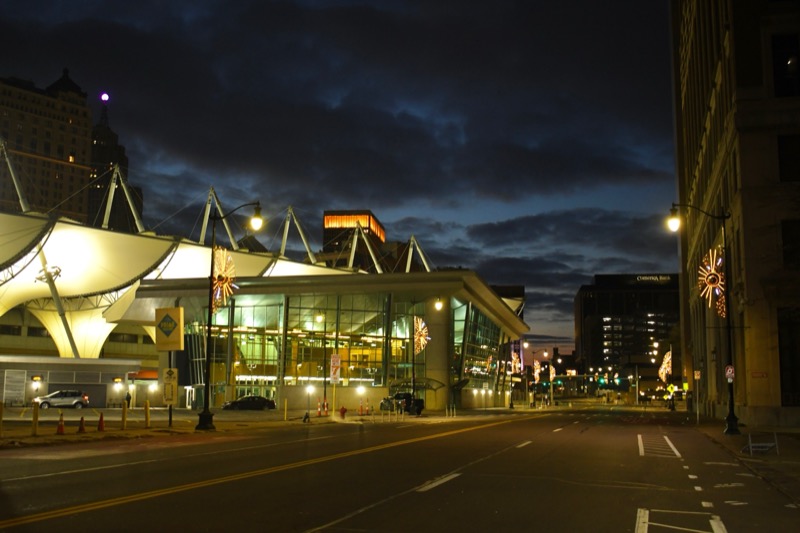
Cass Avenue with the bus terminal at night.
The Lodgings
There are numerous hotels located downtown within walking distance of many of the attractions or are just a short ride away on the People Mover. Many of the hotels are in historic buildings and boast beautiful facades and decadent lobbies. Here are just a few great places to rest your head.
One of the most economical places to stay in any city is a hostel. Painted with colorful murals in a quiet neighborhood, Hostel Detroit offers dorm-style bunk beds to rest your tired bones. Walk-ins are not taken and to access the building you need a code from your online reservation.
With its historic stone façade, friendly staff welcome you at the Double Tree Suites Fort Shelby. As you wait to check in, rest in the spacious, white lounge or grab something for your room at the hotel store. If you don’t feel like venturing out for breakfast, grab a favorite at the Motor City Kitchen within the hotel.
In the heart of downtown, the Hotel Indigo reflects the heart of the Motor City with its Motown-themed deco. A cozy lobby and friendly staff greet you as you walk through the doors. Enjoy a room with modern furnishings and comfy beds.
Nestled in the heart of the lively, happening Greektown, the historic Atheneum, with its beautiful marble lobby, is the place to stay if you want a little luxury. The hotel’s rooms are more economical during the week and are affordable with groups of four.
For a more lavish stay, check out the nearly renovated historic Book Tower. The building boasts a three-story art glass rotunda with more than 6,000 glass panels and intricate, hand-painted plaster ceilings. If you don’t decide to stay, the hotel is a beautiful place to visit to view outstanding architecture from the 1920s.
These are just a few of the awesome attractions to visit in the new must-see city of Detroit. Stay a day or a few and enjoy a city on a rebound filled with grit and charm. You will want to revisit it again and again.

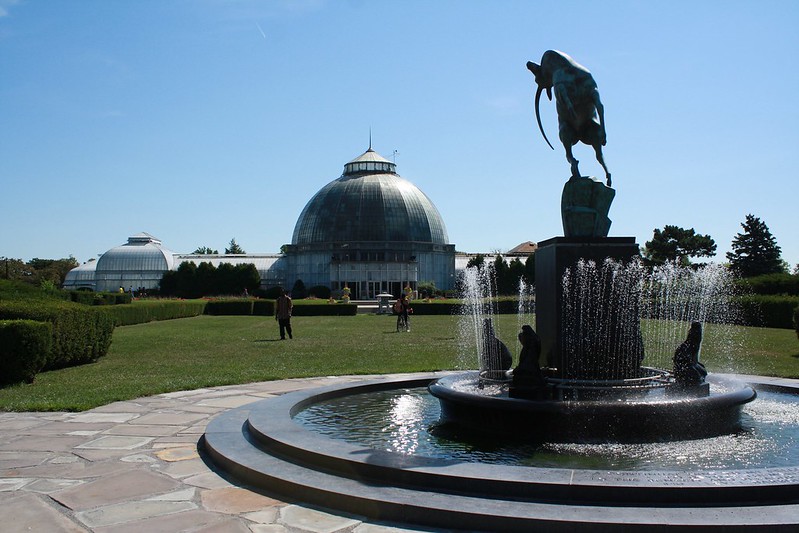



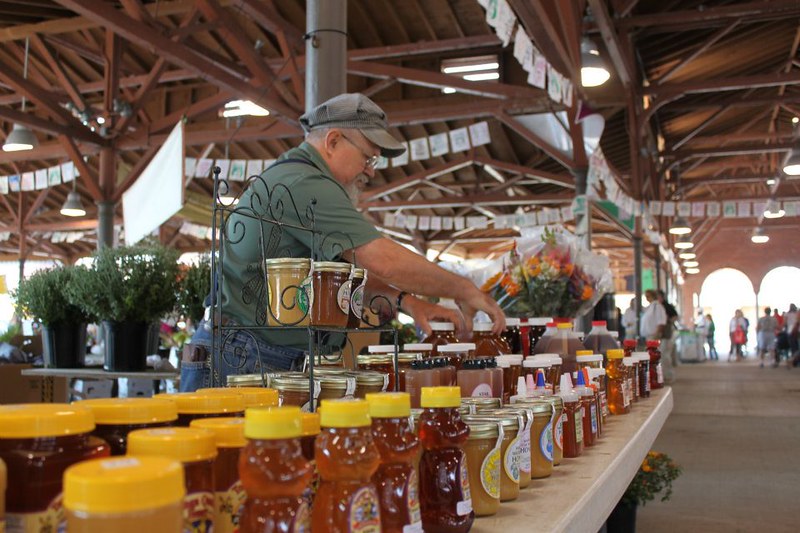
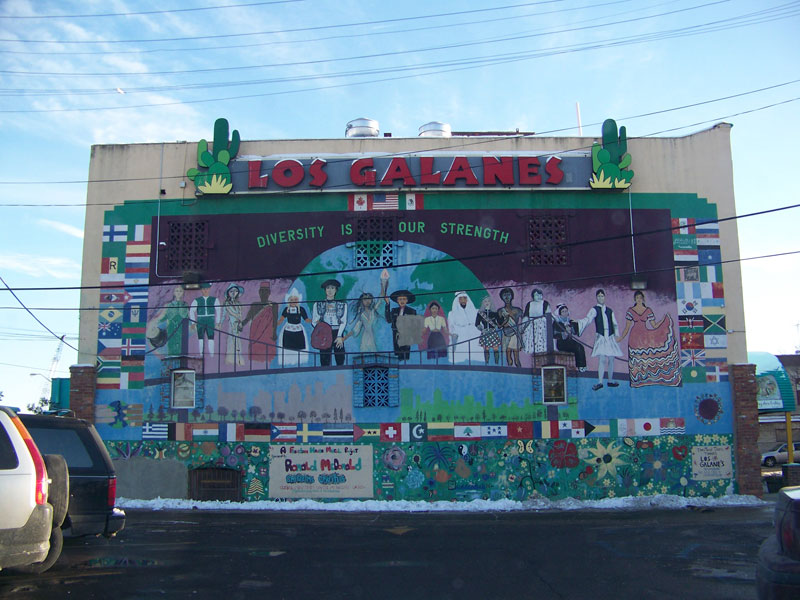

 Best Museums in Washington, D.C., With Exhibits Worth Visiting
Best Museums in Washington, D.C., With Exhibits Worth Visiting Free Things To Do in Fort Worth, Texas
Free Things To Do in Fort Worth, Texas Day Trips from Santa Fe – Places Worth Getting in the Car to See
Day Trips from Santa Fe – Places Worth Getting in the Car to See 6 National Parks in Massachusetts Near Boston Worth Seeing
6 National Parks in Massachusetts Near Boston Worth Seeing
